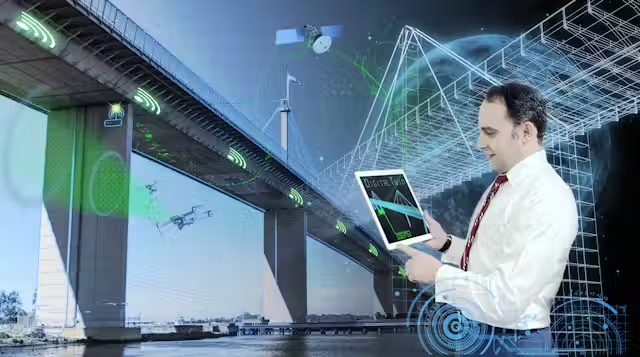Kuwait is rapidly modernizing its infrastructure to meet the demands of a growing population and evolving economic ambitions. Among the transformative technologies shaping this development, digital twins stand out as a game-changer. Digital twins are virtual representations of physical assets, systems, or processes, enabling real-time monitoring, analysis, and optimization. Their application in infrastructure projects allows stakeholders to foresee challenges, optimize designs, and ensure more efficient resource management.
The integration of digital twins in Kuwait is not just a technological advancement; it represents a shift in how the country envisions and executes its infrastructure projects. From roads and bridges to smart buildings and utilities, the adoption of digital twins promises greater efficiency, sustainability, and resilience.
Enhancing Planning and Design
Digital twins offer engineers, architects, and urban planners an unparalleled ability to simulate the behavior of infrastructure before it is built. In Kuwait, where extreme weather conditions and rapid urbanization pose unique challenges, this capability is invaluable.
By creating a digital replica of a project, planners can test different design scenarios, optimize material usage, and predict structural performance under varying conditions. This proactive approach reduces errors, minimizes costs, and shortens project timelines. Furthermore, digital twins facilitate collaboration among different teams, ensuring that all stakeholders can visualize and understand the project in a shared virtual space.
Improving Construction Efficiency
Construction in Kuwait often faces challenges such as high temperatures, logistical constraints, and complex regulatory requirements. Digital twins help overcome these hurdles by offering real-time insights into project progress.
Contractors can monitor construction sites virtually, identify potential delays, and coordinate resources more effectively. By simulating construction processes, teams can detect conflicts early, avoid rework, and ensure that projects stay on schedule. This not only saves time but also enhances the safety of construction workers by predicting hazardous situations before they occur.

Optimizing Infrastructure Maintenance
Once infrastructure projects are completed, maintaining them efficiently becomes crucial. Digital twins play a vital role in asset management by providing a continuous flow of real-time data.
In Kuwait, where infrastructure is exposed to harsh environmental conditions such as high humidity and extreme heat, digital twins help monitor wear and tear on roads, bridges, pipelines, and buildings. Maintenance teams can predict when repairs are needed, allocate resources efficiently, and reduce downtime. This predictive maintenance approach prolongs the lifespan of assets and ensures that public services remain reliable for citizens.
Promoting Sustainability and Environmental Responsibility
Sustainability is a growing priority for Kuwait as the nation works toward greener urban development. Digital twins contribute significantly to this effort by enabling energy efficiency, reducing waste, and minimizing environmental impact.
Through simulations, planners can assess energy consumption, optimize water usage, and reduce emissions in building projects. By analyzing data from digital twins, decision-makers can implement eco-friendly strategies, such as renewable energy integration or improved waste management practices. This alignment with sustainable development goals enhances Kuwait’s global reputation as a forward-thinking, environmentally responsible nation.
Boosting Safety and Risk Management
Infrastructure projects inherently carry risks, including structural failures, accidents, and natural hazards. Digital twins enhance safety in Kuwait by allowing stakeholders to simulate risk scenarios and implement preventive measures.
Emergency response teams can use digital twins to model potential disaster situations, such as floods or seismic events, and prepare contingency plans. Construction managers can monitor site safety in real time, ensuring compliance with safety protocols. By proactively addressing risks, digital twins help safeguard both human life and critical infrastructure investments.
Driving Smart City Initiatives
Kuwait is increasingly embracing the concept of smart cities, integrating technology into urban planning and public services. Digital twins form the backbone of these initiatives by providing a comprehensive virtual view of city infrastructure.
From traffic management to energy grids and public transportation, digital twins allow city planners to monitor systems in real time, optimize operations, and respond to issues swiftly. This interconnected approach improves the quality of life for residents, reduces congestion, and enhances public safety. By leveraging digital twins, Kuwait can transform its urban spaces into intelligent, responsive, and sustainable environments.
Supporting Economic Growth
The adoption of digital twins in infrastructure projects has a direct impact on Kuwait’s economic growth. Efficient project execution reduces costs and attracts foreign investment, while predictive maintenance ensures long-term asset value.
Digital twins also create opportunities for technology-driven jobs, fostering a skilled workforce in engineering, data analysis, and IT. By embracing this innovation, Kuwait positions itself as a regional leader in smart infrastructure development, strengthening its economy and global competitiveness.

Enhancing Decision-Making and Collaboration
One of the most valuable aspects of digital twins is their ability to enhance decision-making. By aggregating data from sensors, design models, and operational systems, digital twins provide a holistic view of infrastructure performance.
Government agencies, contractors, and planners can collaborate effectively, relying on accurate and up-to-date information to make informed decisions. This transparency reduces delays, improves accountability, and ensures that projects meet both technical and societal expectations.
Future Prospects of Digital Twins in Kuwait
The potential of digital twins in Kuwait is enormous. As technology continues to evolve, digital twins will become more sophisticated, integrating artificial intelligence, machine learning, and predictive analytics.
Future infrastructure projects could include fully autonomous monitoring systems, real-time optimization of energy and water resources, and enhanced citizen engagement through virtual platforms. The convergence of these technologies will enable Kuwait to build resilient, efficient, and future-ready infrastructure that meets the demands of its growing population and economy.
Conclusion
Digital twins are revolutionizing Kuwait’s approach to infrastructure development. By enabling efficient planning, improving construction processes, optimizing maintenance, and promoting sustainability, this technology provides tangible benefits that extend across economic, environmental, and societal dimensions.
The adoption of digital twins is more than just a technological upgrade; it represents a paradigm shift in how Kuwait envisions and executes its infrastructure projects. With continued investment and innovation, digital twins have the power to transform the nation’s urban landscape, enhance the quality of life for its residents, and position Kuwait as a leader in modern, intelligent infrastructure development.
Kuwait’s journey toward embracing digital twins reflects a broader commitment to innovation, efficiency, and sustainable growth. As these virtual tools become integral to infrastructure projects, the nation stands on the brink of a smarter, safer, and more prosperous future.
Also Read – Kuwait Revolutionizes Urban Traffic Management with AI Innovation



